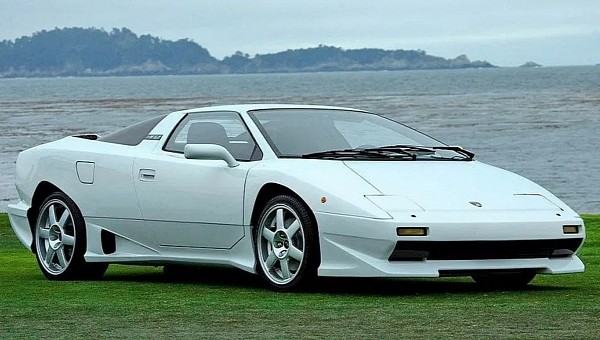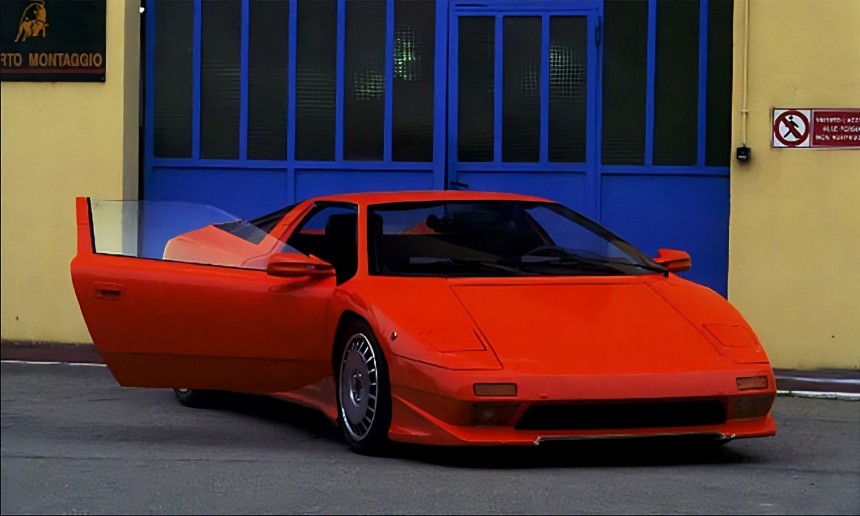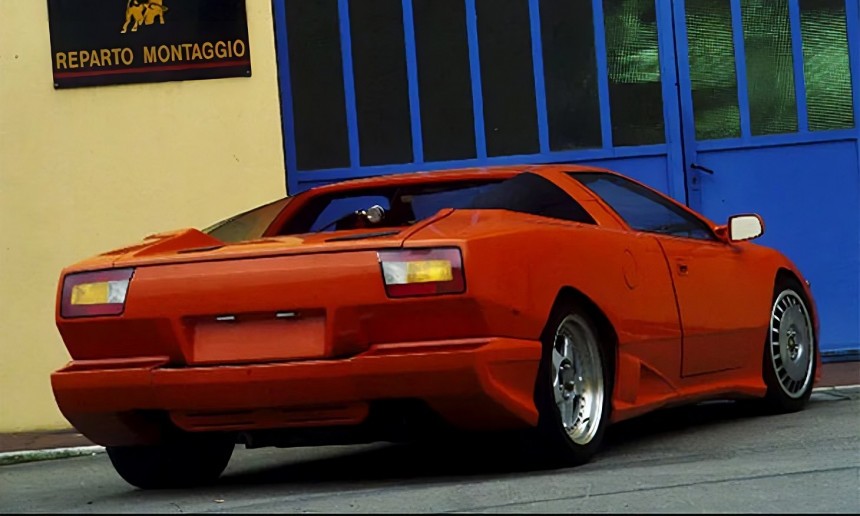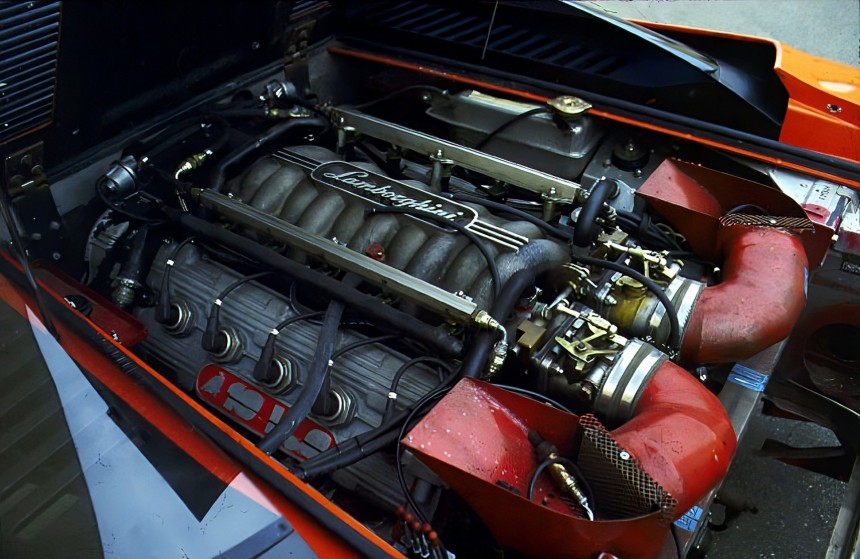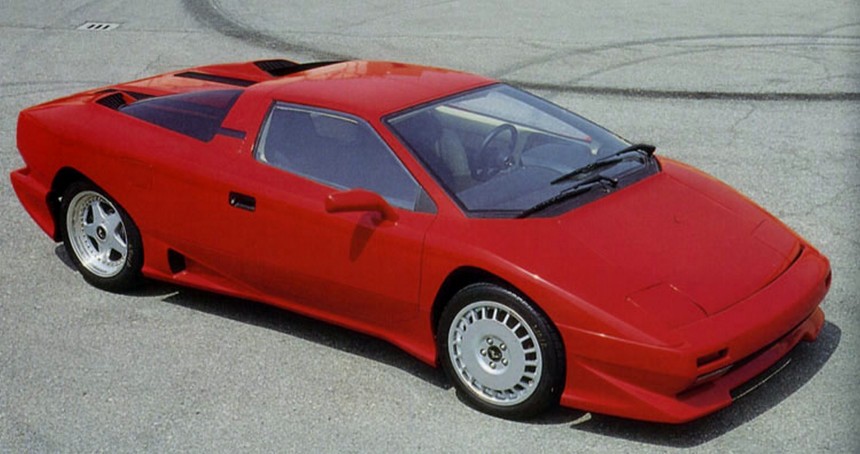It's hard to find a Lamborghini that few have ever seen or heard of. Even Lambo's prototypes and concept cars tend to be remembered long after their time. But based on the existence of the P140, that isn't a rule of thumb. If anything, the P140 prototype's legacy is snuffed out somewhat by contemporary Lambos it bears a striking resemblance to.
If you thought the P140 looked like an artist's rendering of the Huracan or even the Gallardo if it were made in the 1980s, that's pretty much exactly what it was. Lamborghini was a far different manufacturer than it is today in 1987, that's pretty much a given without oversight from Audi. Some purists even argue Lamborghinis were more genuine under independent management than under the thumbs of the Germans.
In terms of engine displacement, chassis size, top speed, and, of course, the price, the P140 was tailor-made to slot comfortably under the Countach, while the Jalpa faded into obscurity. But it was easier said than done, even for old-school Lamborghini. What was needed was a designer intimately familiar with the Lamborghini design language. A person who could consolidate the visual quirks of past Lambos and downsize them just enough to slot beneath the Countach.
Happily, just such a man existed. His name was Marcello Gandini, and his catalog includes designing the Lamborghini Miura, the Espada, the Diablo, the Lancia Stratos, the Renault 5 Turbo, and, of course, the Countach itself. If there was ever a man on Earth who could provide Lamborghini with what they wanted, it was Gandini. He started with a basic wedge shape that'd become iconic 15 years later in the Gallardo.
From there, Gandini anointed this promising basic shape with aggressive wing mirrors, prominent vents atop the rear engine compartment, classic pop-up headlamps, and shiny six-spoke alloy wheels. Also integrated into the new design were cues from the outgoing Countach and the P132 prototype, which became the all-new Diablo. Coincidentally, that P132 would soon be reborn and fitted with a bonkers V16 engine by the Cizeta-Moroder group in the early 1990s.
This V10 jetted 372 horsepower (377 PS) at 7,000 RPM and 390.5 Nm (288 lb-ft) of torque at 5,500 thanks to fancy new electronic fuel injection. This entirely novel, bespoke engine was designed and built in only seven months, while being remarkably light and compact for a V10. That's something you can't say about a Dodge Viper V10 from around the same time. As it happens, Lamborghini was also purported to have played a huge role in bringing the Viper's engine to life. It's like the Chinese yin and yang symbol, but with V10s.
This novel engine helped the P140 sprint from zero to 100 kph (62 mph) in under five seconds in a chassis made partly of lightweight carbon fiber. When a modern Huracan Tecnica does the same dash in 2.8 seconds, that doesn't sound all that great. But in 1987, that was pretty darn quick. The Countach 5000S Quattrovalvole could only manage a 4.7 sprint to 100 kph (62 mph), if that's any perspective. A top speed of 295 kph (183 mph) achieved on the Nardo Ring in Italy isn't bad either.
Moving to the interior, it's clear cabin material quality wasn't exactly a strong suit for Lambo before Audi came around. The Countach halo car wasn't exactly a Nissan in terms of interior quality, but neither was it exactly spacious or comfortable. Inside the P140, we find a similar steering wheel and gear selector for the transmission as inside a Countach, despite the latter only having a five-speed gearbox, compared to the P140's six speeds.
Because Lamborghini's records were spotty before Audi stepped in, it's hard to tell whether three or four P140 examples were built in 1987. At least one fully-functioning, orange-painted prototype was built to test the spicy new V10 at the Nardo Ring. A further rolling chassis was painted red, while a third semi-functional prototype was painted white. At the time, it seemed as though the P140 would enter production under a new name.
But it wouldn't be an old-school Lamborghini story if there weren't a perpetual lack of money issue. The Diablo project to replace the Countach was already in full swing in the late 1980s. Ensuring the model was a success was nothing short of crucial to the long-term health of the company. Knowing this, flight-of-fancy, entry-level prototypes simply couldn't be a higher priority.
One thing's for sure, perhaps the biggest benefit of letting Audi handle Lamborghini is how much better their interior quality's gotten since the early '90s. There's simply no tolerance for brick-like steering, heavy clutches, and poor visibility in the modern supercar space the way there was 30 years ago. At least from this point of view, sharing a corporate umbrella with Volkswagen, Porsche, Bentley, and Bugatti has its obvious virtues.
It's certainly something to think about, knowing Huracan Sterrato will be the final non-hybrid model Lamborghini manufactures. Will the DNA of the P140 live on in some form through the next entry-level Lambo? Given the never-ending success of the Urus, could the next entry-level Lamborghini be an SUV? We shudder at the thought, but it's no more absurd than the Mustang GT. Safe to say, the cat's out of the bag on making SUVs out of sports cars.
It's hard to say where the winds will blow Lamborghini's design philosophy going forward. Some even fear the trademark, visceral lunacy of classic Lambos could fizzle away in an all-electric future the industry is being forced to undertake in the 2020s. But enough of the Debbie Downer complex. Instead, let's choose to celebrate what's been great about the brand up until this point.
Check back soon for more supercar prototype profiles right here on autoevolution.
An all-new kind of Lambo
At the time, Lambo fielded two bespoke sports cars, the V8-powered pocket rocket the Jalpa and the V12-powered spaceship of a machine we all know and love, the Countach. In the mid to late 1980s, Lamborghini desired a sports car that bridged the gap between the V8 Jalpa and the V12 Countach. Essentially, a Gallardo or a Huracan before those two were a glimmer in the eye of an Audi executive.In terms of engine displacement, chassis size, top speed, and, of course, the price, the P140 was tailor-made to slot comfortably under the Countach, while the Jalpa faded into obscurity. But it was easier said than done, even for old-school Lamborghini. What was needed was a designer intimately familiar with the Lamborghini design language. A person who could consolidate the visual quirks of past Lambos and downsize them just enough to slot beneath the Countach.
Happily, just such a man existed. His name was Marcello Gandini, and his catalog includes designing the Lamborghini Miura, the Espada, the Diablo, the Lancia Stratos, the Renault 5 Turbo, and, of course, the Countach itself. If there was ever a man on Earth who could provide Lamborghini with what they wanted, it was Gandini. He started with a basic wedge shape that'd become iconic 15 years later in the Gallardo.
From a simple shape, an icon is born
What resulted from Gandini's visual experiment was a car that, from a modern perspective, looks eerily close to the Gallardo. It's a trick of the eye so profound it's almost like our brains won't allow us to believe this is anything other than a Gallardo from an alternate 1980s. You'd be inclined to believe the P140 is a Gallardo from another dimension by the engine Lamborgini opted for in the. It was a dual-overhead-cam, 4.0-liter V10 engine with four valves per cylinder mounted in the middle and paired to the rear wheels only.This V10 jetted 372 horsepower (377 PS) at 7,000 RPM and 390.5 Nm (288 lb-ft) of torque at 5,500 thanks to fancy new electronic fuel injection. This entirely novel, bespoke engine was designed and built in only seven months, while being remarkably light and compact for a V10. That's something you can't say about a Dodge Viper V10 from around the same time. As it happens, Lamborghini was also purported to have played a huge role in bringing the Viper's engine to life. It's like the Chinese yin and yang symbol, but with V10s.
This novel engine helped the P140 sprint from zero to 100 kph (62 mph) in under five seconds in a chassis made partly of lightweight carbon fiber. When a modern Huracan Tecnica does the same dash in 2.8 seconds, that doesn't sound all that great. But in 1987, that was pretty darn quick. The Countach 5000S Quattrovalvole could only manage a 4.7 sprint to 100 kph (62 mph), if that's any perspective. A top speed of 295 kph (183 mph) achieved on the Nardo Ring in Italy isn't bad either.
Lacking in the interior
In fairness, there's the sense there's a fair bit more headroom and rear-facing visibility in the P140 than in the Countach. Surprisingly, only 32 lb (14.5 kg) separate the curb weights of the P140 (1,286 kg/2,835 lb) and the Countach LP400 (1,300.5 kg/2,867 lb). It's anyone's guess whether the P140 was as difficult and temperamental to drive as its Countach big brother.Because Lamborghini's records were spotty before Audi stepped in, it's hard to tell whether three or four P140 examples were built in 1987. At least one fully-functioning, orange-painted prototype was built to test the spicy new V10 at the Nardo Ring. A further rolling chassis was painted red, while a third semi-functional prototype was painted white. At the time, it seemed as though the P140 would enter production under a new name.
But it wouldn't be an old-school Lamborghini story if there weren't a perpetual lack of money issue. The Diablo project to replace the Countach was already in full swing in the late 1980s. Ensuring the model was a success was nothing short of crucial to the long-term health of the company. Knowing this, flight-of-fancy, entry-level prototypes simply couldn't be a higher priority.
The right car at the wrong time
That didn't stop Lambo from building another V10-powered prototype in 1995 and calling it the Cala. Is it any wonder Lambo got bought out by Audi now? All quips aside, it's hard to argue the P140 didn't have a profound impact on Lamborghini's design philosophy. Would the Gallardo have taken the world by storm and become the best-selling non-SUV the company ever had if the P140 hadn't forged the architecture for an entry-level Lambo?One thing's for sure, perhaps the biggest benefit of letting Audi handle Lamborghini is how much better their interior quality's gotten since the early '90s. There's simply no tolerance for brick-like steering, heavy clutches, and poor visibility in the modern supercar space the way there was 30 years ago. At least from this point of view, sharing a corporate umbrella with Volkswagen, Porsche, Bentley, and Bugatti has its obvious virtues.
It's certainly something to think about, knowing Huracan Sterrato will be the final non-hybrid model Lamborghini manufactures. Will the DNA of the P140 live on in some form through the next entry-level Lambo? Given the never-ending success of the Urus, could the next entry-level Lamborghini be an SUV? We shudder at the thought, but it's no more absurd than the Mustang GT. Safe to say, the cat's out of the bag on making SUVs out of sports cars.
It's hard to say where the winds will blow Lamborghini's design philosophy going forward. Some even fear the trademark, visceral lunacy of classic Lambos could fizzle away in an all-electric future the industry is being forced to undertake in the 2020s. But enough of the Debbie Downer complex. Instead, let's choose to celebrate what's been great about the brand up until this point.
Honoring an innovator
If you do want to pay respects to the P140, the third white-painted example produced currently resides at the Museo Lamborghini. The official, company-funded museum of all things Lamborghini in Sant'Agata Bolognese, Emilia-Romagna, Italy. For that and for so many other reasons, making that trip is a sacred pilgrimage for petrolheads.Check back soon for more supercar prototype profiles right here on autoevolution.
